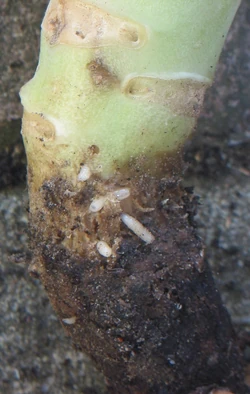| Cabbage root fly | |||||||||||||||||||||||||||||||||||||||||||||||||
|---|---|---|---|---|---|---|---|---|---|---|---|---|---|---|---|---|---|---|---|---|---|---|---|---|---|---|---|---|---|---|---|---|---|---|---|---|---|---|---|---|---|---|---|---|---|---|---|---|---|
 |
|||||||||||||||||||||||||||||||||||||||||||||||||
| Cabbage root fly larvae on a cauliflower stem | |||||||||||||||||||||||||||||||||||||||||||||||||
| Scientific Classification | |||||||||||||||||||||||||||||||||||||||||||||||||
| Kingdom: | Animalia | ||||||||||||||||||||||||||||||||||||||||||||||||
| Phylum: | Arthropoda | ||||||||||||||||||||||||||||||||||||||||||||||||
| Class: | Insecta | ||||||||||||||||||||||||||||||||||||||||||||||||
| Order: | Diptera | ||||||||||||||||||||||||||||||||||||||||||||||||
| Section: | Schizophora | ||||||||||||||||||||||||||||||||||||||||||||||||
| Family: | Anthomyiidae | ||||||||||||||||||||||||||||||||||||||||||||||||
| Subfamily: | Anthomyiinae | ||||||||||||||||||||||||||||||||||||||||||||||||
| Tribe: | Hydrophoriini | ||||||||||||||||||||||||||||||||||||||||||||||||
| Genus: | Delia | ||||||||||||||||||||||||||||||||||||||||||||||||
| Species: | Delia radicum | ||||||||||||||||||||||||||||||||||||||||||||||||
| Risk period | |||||||||||||||||||||||||||||||||||||||||||||||||
|
|||||||||||||||||||||||||||||||||||||||||||||||||
| Synonyms | |||||||||||||||||||||||||||||||||||||||||||||||||
| Cabbage fly Cabbage maggot |
|||||||||||||||||||||||||||||||||||||||||||||||||
Cabbage root fly (Delia radicum), known variously as the cabbage fly, root fly or turnip fly, is a pest of crops. The larvae of the cabbage root fly are sometimes known as the cabbage maggot or root maggot. The adult flies are approximately 1cm (½in) long and are grey in colour but otherwise resemble the common house fly. Pupae overwinter in the soil close to brassica roots.
Symptoms[]
Growth is stunted, more-so if infected as seedlings. Roots turn black and rot and leaves are discoloured and wilted.
Treatment[]
Either spray with a chemical treatment or dig up all affected plants. Chemical treatment will not cure plants and a lower yield should be expected. There is no known organic treatment.
Prevention[]
Flies feed on pollen and nectar, particularly that of cow parsley. When cow parsley flowers the first generation of root fly are at large and preventative protection should already be in place. Putting collars around plant stems will stop the female root fly laying her eggs close enough to the plants for the maggots to reach. Alternatively; using a fine mesh over plants and beds will stop flies getting close to crops as well as providing an excellent barrier for many other crops.
References[]
- ↑ (1994). Food From Your Garden & Allotment. Reader's Digest Association Ltd, London. ISBN 978 276 44336 7
| Brassica troubles |
|
|---|---|
| Broccoli · Brussels sprout · Cabbage · Cauliflower · Kale · Kohl rabi · Radish · Swede · Turnip | |
| Adverse conditions | Blown sprouts · Bolting · Boron deficiency · Button cauliflower · Calcium deficiency · Heartless cabbage · Magnesium deficiency · Manganese deficiency · Molybdenum deficiency · Nitrogen deficiency · Split heart |
| Diseases | Anthracnose · Bacterial soft rot · Black leaf spot · Black rot · Brassica dark leaf spot · Club root · Downey mildew · Grey leaf spot (Brassica) · Turnip mosaic virus · Sclerotinia rot · White leaf spot · White leaf spot (Brassica) · White rust · Wire stem |
| Pests | Aphid · Cabbage aphid · Cabbage Moth · Cabbage root fly · Cabbage Whitefly · Cutworm · Diamondback moth · Flea beetle · Large White · Pigeon · Silver Y moth · Slug · Small White · Swede midge · Thrips |